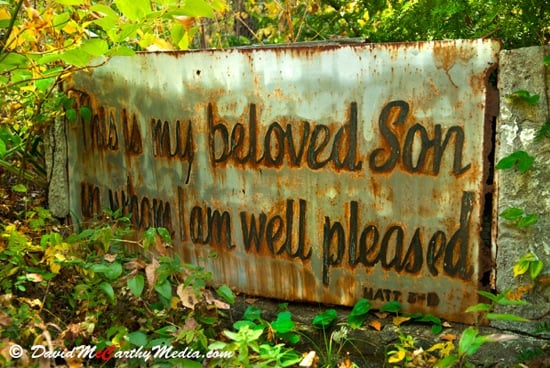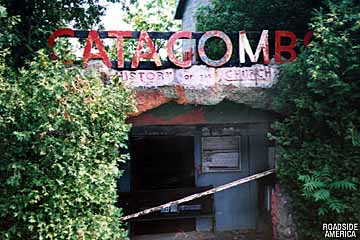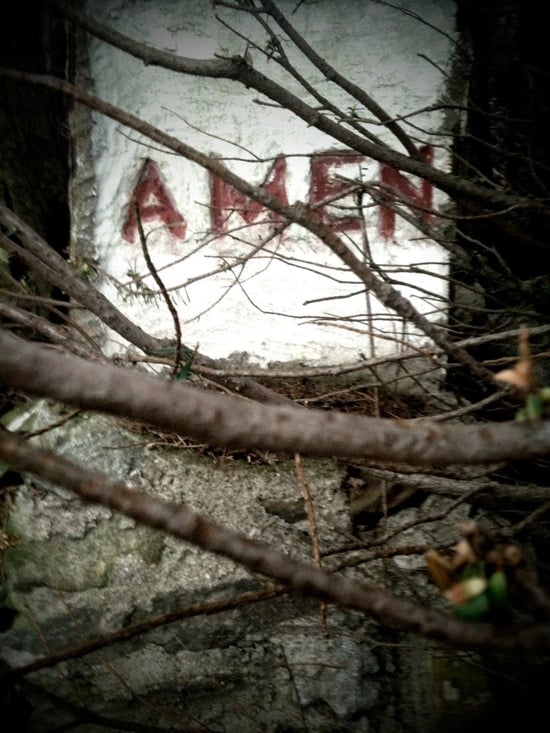Onward Christian Tourists
By:
December 13, 2011
This article was first published in Hermenaut #15 (Summer 1999). Hermenaut was published and edited from 1991-2000 by HiLobrow cofounder Joshua Glenn. Click here to read more from Hermenaut and Hermenaut.com.

If you believe, and it should be proven false, you will receive all blessings as if it had been true, because you believed it to be true. — Pope Urban VIII
Genesis
Occupying seventeen acres just off Interstate 84 in Waterbury, Connecticut, Holy Land USA is the rotting corpse of your standard tacky religious theme park. Built in the late ’50s by a 4’11” man with a vision (and the unlikely name of John Baptist Greco), the place boasts a plywood Jerusalem, sheet-metal biblical dioramas, and forty-one paths lined with crudely-crafted homilies like “honor his heroes the saints” and “statues & pictures are avenues that lead to the soul.” According to The Wall Street Journal, Holy Land USA once attracted busloads of Christians — 40,000 a year, on average. The park was shut down when Greco died, in 1986, and since then it has been neither maintained nor demolished. The only visitors to the park these days fall into two groups: hopeful Christians, who spot the 54-foot illuminated cross from the highway and follow it like the wise men followed the star, and who must weep to see the dilapidation and desecration; and cynical devotees of roadside kitsch, like us.
If you ever decide to visit Holy Land USA, don’t bring your Visa card: The gift shops and the hot dog stands are boarded-up. And don’t take anything you can’t replace — like your life, for example. If you’re trying to get right up to the foot of the cross itself, you’ll have to travel up a pixie mountain to a spot that is secluded, abandoned, and referred to by the locals as “Waterbury’s murder capital.” You know that cliché about the fear of God? It will take on new meaning at Holy Land USA. Creepiness sulks in the air; the thought, “Someone must have died here,” is inescapable… but what you end up saying is, “Someone must have worshipped obsessively here.”
On the day we made our pilgrimage, we drove in endless circles, trying to get to the big cross as it slipped in and out of our vision behind Waterbury’s pawnshops, abandoned factories, burned-out houses, and crumbling apartment buildings. Groups of thugs hanging out on the street corners stared at us. Frustrated, we prayed to the patron saint of everything missing: “St. Anthony, come around / Something’s lost and must be found” — and just then we spotted a small white sign bearing one hand-painted word: Holy Land.
We followed the winding drive to the decidedly unpearly gates. (Because there is no fence at Holy Land, the gates-chained shut-are simply a symbolic warning to “Abandon all hope, ye who enter here.”) Dodging bailing wire, we tromped through a miniature, war-torn Bethlehem and stumbled through the Stations of the Cross, feeling like we had discovered the set of Honey, I Shrunk the Bible. We attempted to reconstruct the scores of scripture quotes painted on warped, faded plywood signs. Baby Jesus had been stolen from the stable — hell, the whole gang was gone except for a lonely, earless sheep — and the graffiti-covered catacombs were filled, not with the bones of Christian martyrs, but with broken beer bottles and fast-food wrappers. A water-stained mattress and torn blanket suggested that someone may have been living there.
From its not-so-immaculate conception, our jaunt to Holy Land USA was envisioned as just another kooky Roadside America stop in a day of Connecticut tourism that included both jai alai and Mark Twain’s house in Hartford. However, the Holy Land leg of our trip left us — if not profoundly moved, at least emotionally nudged. Whether by religious training or tricks of reasoning, we drew different conclusions to the question: “Was God here?”
The Gospel According to Mary
Once, when I was visiting New Mexico, I stopped at a church nine miles east of Espanola. It was a cloudy day, and as I was walking up to the damp, dirt-floored adobe church, the sky looked like it was about to dump a serious load of the Lord’s wrath on us. I went in, took the free tour, and came out to the back where I found a little open-air chapel and — good day, sunshine! — the clouds were gone, the sun was out, the typical red-brown New Mexican dirt was covered with green grass and, I kid you not, butterflies. I was overcome by a feeling of, in a word, serenity.
I had no idea, at the time, that I had just visited El Sanctuario De Chimayo, the Lourdes of America. Years later, I happened to read about how, sometime in the early 1800s, a friar there saw light “bursting” from the hillside. He dug at the spot and found a wooden crucifix (or maybe just a cross, the brochure wasn’t too explicit) which he brought to a nearby church. The crucifix disappeared in the night and was later found back underground. The hillside was declared a holy place, and a chapel was built over it. Miraculous healings followed — God can be so predictable — and today pilgrims go there to spoon dirt from the floor into baggies.
So did I have some kind of authentic religious experience at Chimayo? Or did my sensations of tranquillity just mirror what I’d been trained to expect from a “religious experience”? Sun equals good, right? Bleak, dark church equals bad, no? Maybe a place like Holy Land could “illuminate” such matters. The truth is, I had no intention of ever visiting a place like Holy Land. I was simply an agnostic prisoner in a car of curious Catholics.
Two things impressed me about Holy Land: its unburied death and its lack of gift shopping. At no point were we distracted by cute mementos. Thus, we were forced to concentrate on the visual, spatial history of Holy Land USA. Greco’s severe message — your sins, their nails, his blood — has only been made more powerful by Holy Land’s decrepitude. We had no way of knowing what Holy Land looked like in its perky heyday: We can imagine a more manicured place, but we have seen no pictures, spoken with no pilgrims. Souvenirs would have only freed us from actually having to experience the place; we didn’t have the comfort of knowing we could always take it all in later, in the safety of our own homes and belief systems. Holy Land asked more of us than that. It asked us for our immediate reckoning.

But as much as I would like to say I found Holy Land USA to be a sacred place, I can’t. I would like to say I was inspired by John Baptist Greco’s effort, but I wasn’t. Some of Greco’s red-lettered biblical excerpts did touch me: “There is no fear in love,” for example. But it was hard to be moved when I was afraid for my physical life. (Will I die by tetanus or by gunshot?) At the same time, I found the macabre contortions of Christianity that surrounded me — or maybe it was Christianity itself — unnerving. Holy Land is a scene of worship given way to human frailty: Pews have been kicked over, statues torn apart. In the bowels of the catacombs, as my fellow pilgrims stood pondering the green, glowing replica of Lourdes, I couldn’t help feeling exposed to a bad element: gangsters lurking in the shadows, decomposed bodies of homeless people, the whispery voice of Satan.
Actually, the underlying discomfort I have about Holy Land has less to do with the elements of vandalism and natural decay and more to do with the aberrations of human passion. Greco sought an inordinate amount of attention, not from the flock of visitors whom he probably genuinely wanted to teach, but from God. Like a schoolboy, Greco cried, “Look at me, God! I did extra-credit!” I hope I’m not just jealous; I was always a sub-par student. But I do wonder at the triviality of it all: Could the recycled kitsch that is Holy Land USA be just another example of how the Devil uses idle hands to mock religious inspiration? Greco’s fervor may have been authentic, but to me he just seems like one of those pilgrims who visit Medjugorje in Bosnia, then come home and have a vision of their own, as if they’ve just purchased a franchise.
A shrine need not be made of marble; a visionary need not have taste or artistic talent. But try as I might to take Greco and his creation seriously, all I could think was: Why couldn’t the guy just build a homeless shelter, or a hospital? Of course, someone, someday, will probably look at my life’s work and ask exactly the same thing. So maybe I fear that, too.
The Gospel According to Julie
I’m a “recovering Catholic,” it’s true. But I can’t just laugh at Nunsense and leave it at that. After seventeen years of Catholic school, I do have my “issues” with the Church, but faith dies hard when you have an uncle who’s a priest, a father who’s a captain of the ushers, a mother who’s a card-carrying member of the Legion of Mary, and a childhood friend who’s joined a convent. I feel like I must be missing something, that I’m the only one who didn’t get the memo. Part of me wishes I could just wake up on Sundays and not feel guilty about not going to Mass. But another part of me envies the fervent belief that drives martyrs to welcome the lion’s embrace, or that leads a man like John B. Greco to build a Holy Land out of the only stuff he could afford: chicken wire, pressboard, tin-foil.
Although I’ve never been to the real Holy Land, I have climbed the winding stairs to the roof of St. Peter’s Basilica in Rome, and I’ve suffered through a two-hour-long High Mass at Notre Dame in Paris. Like thousands of other pilgrims over the centuries, I have gawked at the preserved bodies of saints in European cathedrals. That’s why the many American pilgrimage sites I’ve visited — places like “The World’s Largest Crucifix” in Bardstown, Kentucky, and the imposing “Christ of the Ozarks” in Eureka Springs, Arkansas — have always struck me as being, well, laughable. In some ways, it’s hard to see much difference between the World’s Largest Crucifix and the World’s Largest Ball of Twine.
I went to the University of Notre Dame, a school started by priests to provide a Catholic education for the children of farmers. There, I discovered a world where pilgrimages end at the stadium, where people pray to win football games, and where the giant mural of Christ on the library façade is dubbed “Touchdown Jesus.” More recently, I saw Pope John Paul II say Mass in Central Park. My ticket was “obstructed view,” to say the least: I sat on bleachers, somewhere on the other side of a wall of trees from His Holiness, and watched him on a video screen. People around me bought Pope buttons and pennants… and ate hot dogs during Mass.
A few years ago, however, I attended a happening at the Shrine of Our Lady of the Snows in Belleville, Illinois. This place is a replica of Lourdes, just another pathetic American imitation of a Vatican-approved European shrine. Back in 1993, a retired truck driver named Ray Doiron claimed that he was being visited there by the Virgin Mary. Thousands of people showed up to pray with Ray, who would go into a trance, then claim that the Virgin had appeared. He would repeat her bad-ass edicts: “I am the woman clothed in the sun, and my mission is the conquering of Satan, and to crush the head of the serpent who has come between God and man.” Although I quickly tired of my fellow pilgrims, particularly the Filipino woman who showed me pictures of clouds that supposedly looked like Jesus and Mary, I couldn’t help feeling that Ray was the real deal. He radiated a kind of spiritual peace that I’ve only seen once since, when I attended a lecture by Sister Helen Prejean, the author of Dead Man Walking. Plus, Ray wasn’t selling any T-shirts.
Maybe that’s why, although I know we “recovering” Catholics are supposed to “love” places like Holy Land USA for their kitsch value (you know, the way you love cheese like Charlie’s Angels), as I stood there, wearing an Ozzy T-shirt amid the ruins of John Greco’s dream, I wasn’t smirking. I was thinking about my First Communion. I envisioned the photo my parents have of me as a seven-year-old, wearing my white dress and patent leather shoes, hands folded reverently. I realized that, like Holy Land USA, I have decayed; I have been vandalized by my own cynicism.
I don’t think Greco’s zealotry, his passion and his ingenuity (how many men could look at a discarded washing machine and see it as the temple where Boy Jesus is instructed the Elders?) are laughable. Despite myself, I found that his gaudy display, or what’s left of it, has meaning and the capacity to inspire. Although I am nostalgic about the Catholicism of my childhood in some ways, I find that I admire giant-cross-building freaks for having the courage of their convictions. The conformism of “recovering Catholics” is not that different, in the end, than the conformism of those Mass-attending Catholics they used to be. At least someone like Greco stood alone, and did something extraordinary.
Revelations
Today at Holy Land USA, the dioramas have been beaten down. The park’s aura of creepiness is probably nothing more than the residue of years of abuse from the vandals, from the elements. In defiance, the most moving diorama stands in the long shadow of the illuminated cross. It depicts a Calvary where Jesus — his whole right arm torn off and nowhere to be found — still hangs, miraculously suspended from the cross.

